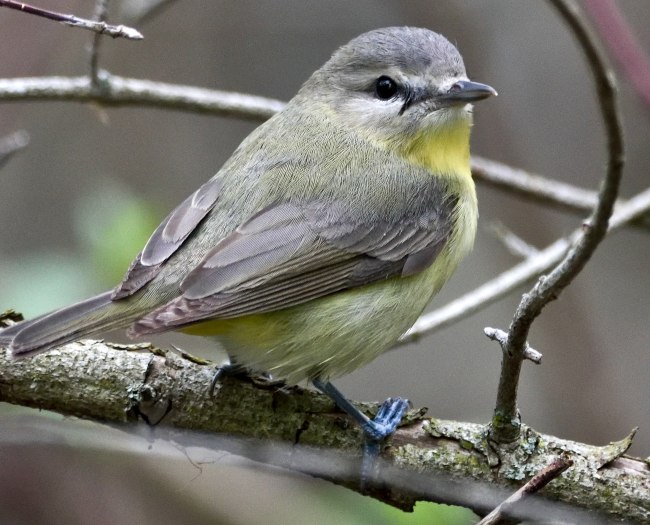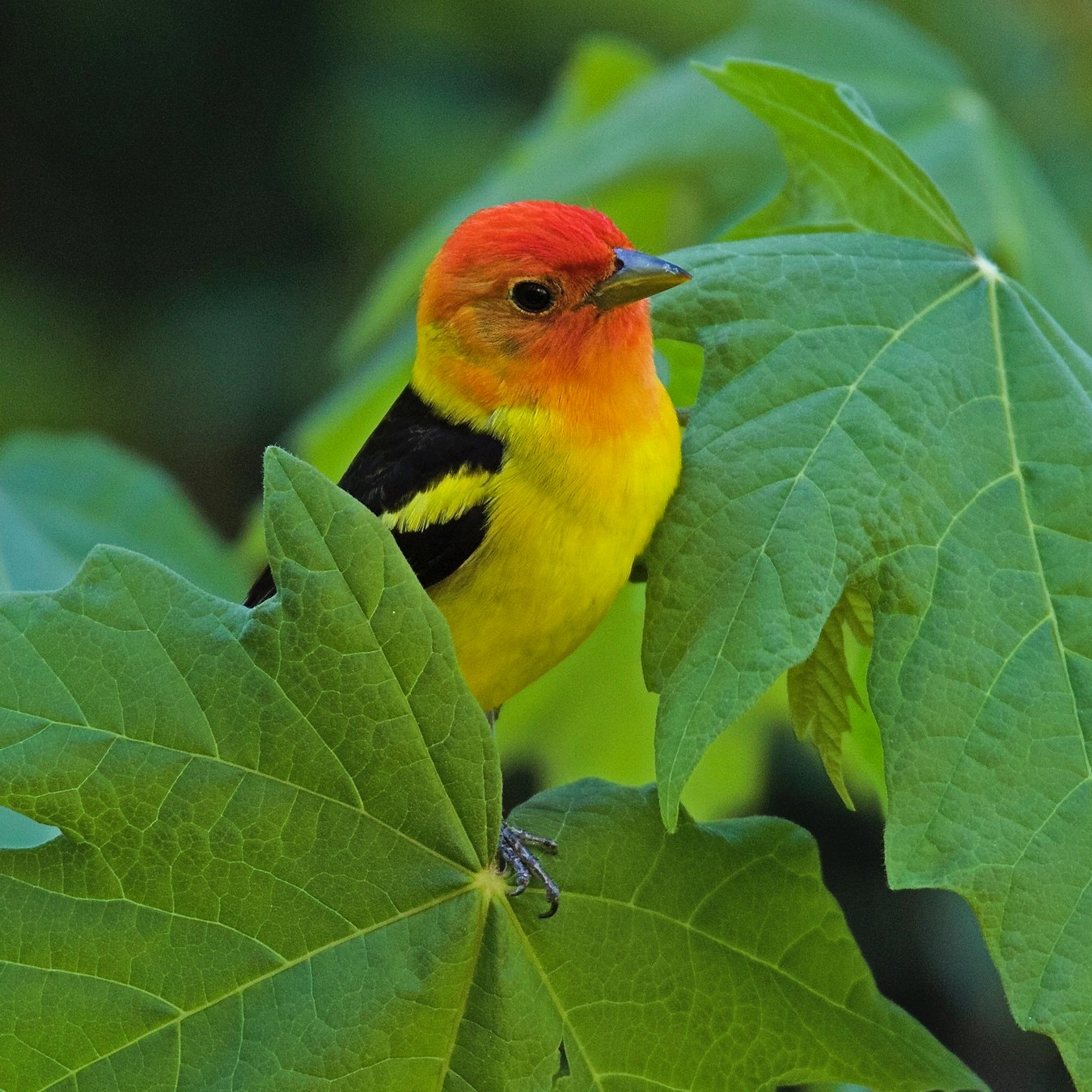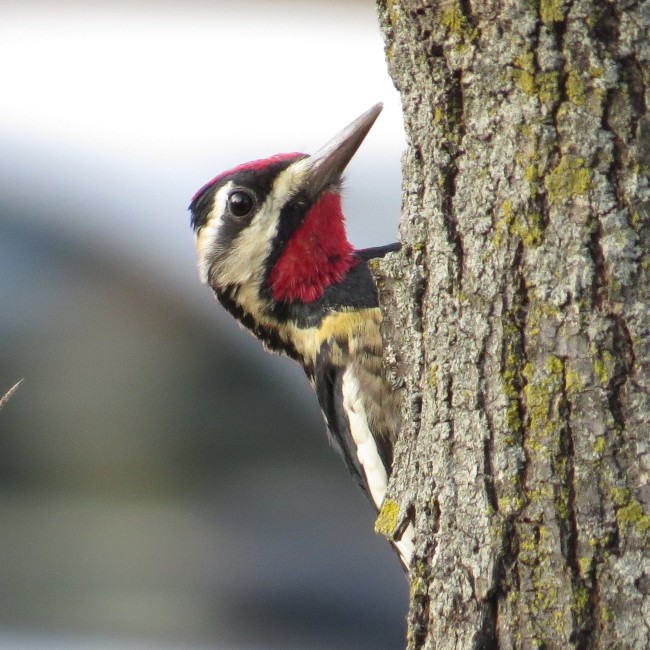Status of Old-forest Birds
In this section we explore how human disturbance affects birds associated with old mixedwood and deciduous forests.
The overall intactness of old-forest bird species as measured by the Biodiversity Intactness Index was found to be, on average:
91.2%
Northern Operating Area
84.7%
Southern Operating Area
- This means most of the habitat for old-forest birds is in good condition, but habitat suitability is lower in some areas due to human development activities.
- Habitat suitability is higher in the Northern Operating Area because there is less human footprint in this landbase compared to in the Southern Operating Area.
Introduction
Old deciduous and mixedwood forests provide important habitat to a range of bird species [1 ,2] ; for example:
- these forests supply an abundance of nesting sites for cavity-nesting birds, like the Pileated Woodpecker and Red-breasted Nuthatch.
- the leaves of deciduous trees host numerous herbivorous insect species gleaned by canopy-foraging birds, like the Blue-headed Vireo.
- the complexity in the habitat structure of deciduous and mixedwood forests, including an abundance of shrubs and a mixture of deciduous trees of various sizes and decay states, allows more species to coexist.
- finally, old mixedwood stands with even a few White Spruce trees support species that are often found in coniferous forests, such as the Brown Creeper.
Overall, deciduous and mixedwood forests support a greater diversity of birds than younger stands or coniferous forests, although a range of stand types and forest age classes are important to support the full suite of bird species.
Intactness and sector effects are summarized for bird species associated with old deciduous and mixedwood forests in Norbord’s operating areas. Details for calculating intactness and sector effects can be found in the Methods.
 Photo: Victor Manuel Espinosa
Photo: Victor Manuel Espinosa
Philadelphia Vireo (Vireo philadelphicus)
Results
Biodiversity Intactness
The overall intactness of old-forest bird species as measured by the Biodiversity Intactness Index was found to be, on average:
Northern Operating Area
91.2%
19 species
Southern Operating Area
84.7%
19 species
Partner Operating Area
88.1%
19 species
2018 Highlights
- Habitat suitability for old-forest bird species, as indicated by intactness, is higher in the Northern Operating Area compared to in the Southern and Partner Operating Areas; this can be attributed to the lower amount of human footprint in the north.
- Although habitat suitability was slightly higher in the north compared to the south for old-forest birds, the same species consistently showed the largest deviation from intact reference conditions in all three operating areas, including: Brown Creeper, Black-throated Green Warbler, Winter Wren, Bay-breasted Warbler, and Western Tanager.
- Old-forest birds are disproportionately affected by human footprint because, as of 2018, 46% and 49% of human footprint had occurred in deciduous and mixedwood forest in the Northern and Southern Operating Areas.

Western Tanager
(Piranga ludoviciana)

Yellow-bellied Sapsucker (Sphyrapicus varius)
Results
Sector Effects
Local Scale Sector Effects
Local scale sector effects are used to understand what industrial sectors are most affecting the abundance of bird species associated with old deciduous/mixedwood forests in Norbord’s operating areas. Changes in species relative abundance are predicted within each sector’s footprint compared to the reference conditions with no human footprint.
- All types of human disturbances greatly decrease habitat suitability for most bird species associated with old deciduous/mixedwood forests in Norbord’s operating areas because these activities impact their preferred habitat.
- Within forestry footprint, the abundance of most old-forest bird species is predicted to be less abundant than expected compared to in the habitat it replaces, with half of the old-forest birds predicted to be more than 50% less abundant.
- Two species—Yellow-bellied Sapsucker and Philadelphia Vireo—while associated with old-forest habitat, also respond positively to harvest areas and are therefore more abundant than expected in forestry footprint.
Regional Population Effects
Regional population effects reflect the total expected change for the population of each old forest bird species across Norbord’s operating areas due to each sector’s footprint. This incorporates the area of the footprint, the native habitats in the region where the footprint occurs, and the species response to a particular footprint. The calculation also incorporates the entire landbase of each operating area, large tracts of which have no human footprint.
- Regional effects are much less than local scale effects because a great deal of old forest bird habitat has not been disturbed by human footprint in the operating areas; regional effects are larger in the south because of higher footprint there.
- Regional population effects from energy, transportation, and urban/industrial footprint on birds associated with old deciduous/mixedwood forest were small—ranging from between -3.0% and +1.0% in both operating areas.
- Forestry footprint resulted in the largest predicted changes to suitable habitat for many old forest birds—on average -6.5% and -9.3% in the Northern and Southern Operating areas, respectively—because harvesting is the largest footprint type in both regions. Several species are predicted to decrease by at least 10% at the regional scale as a result of forestry footprint in each operating area, for example Brown Creeper and Black-throated Green Warbler.
To view species-specific sector effects, use the drop-down menu to select a species of interest.
Northern Operating Area - Local Scale Sector Effects
Figure: Local Scale Sector Effects. Predicted per cent change in species' relative abundance inside areas that have been disturbed by each sector (human footprint type) compared to reference conditions with no human footprint. Local scale sector effects values less than 0% indicate fewer birds in that type of footprint than in the reference habitat; greater than 0% indicate more birds.
Northern Operating Area - Regional Scale Sector Effects
Figure: Regional Sector Effects. Predicted per cent change in the total regional population of birds, by species, due to the footprints of each industrial sector. Regional sector effect values less than 0% indicate a predicted decrease in the regional population due to a sector's footprint and values greater than 0% indicate a predicted increase. Note that sector effects consider only the direct impact of disturbed areas and do not consider edge effects or other non-footprint effects (e.g. noise, pollution).
Southern Operating Area - Local Scale Sector Effects
Figure: Local Scale Sector Effects. Predicted per cent change in species' relative abundance inside areas that have been disturbed by each sector (human footprint type) compared to reference conditions with no human footprint. Local scale sector effects values less than 0% indicate fewer birds in that type of footprint than in the reference habitat; greater than 0% indicate more birds.
Southern Operating Area - Regional Scale Sector Effects
Figure: Regional Sector Effects. Predicted per cent change in the total regional population of birds, by species, due to the footprints of each industrial sector. Regional sector effect values less than 0% indicate a predicted decrease in the regional population due to a sector's footprint and values greater than 0% indicate a predicted increase. Note that sector effects consider only the direct impact of disturbed areas and do not consider edge effects or other non-footprint effects (e.g. noise, pollution).
References
Schieck, J., M. Nietfeid, and J.B. Stelfox. 1995. Differences in bird species richness and abundance among three successional stages of aspen-dominated boreal forests. Canadian Journal of Zoology 73:1417-1431.
Bunnell, F.L., L.L. Kremsater, and E. Wind. 1999. Managing to sustain vertebrate richness in forests of the Pacific Northwest: relationships within stands. Environmental Review 7(3):97-146. doi:10.1139/er-7-3-97.




